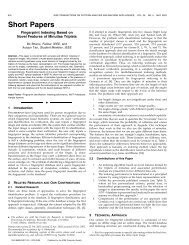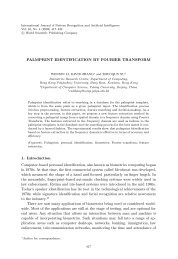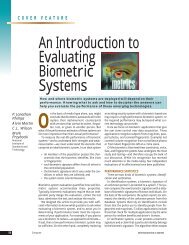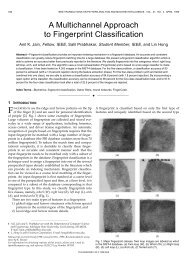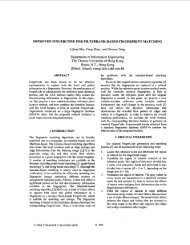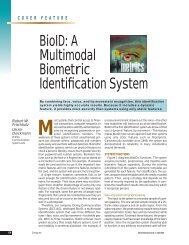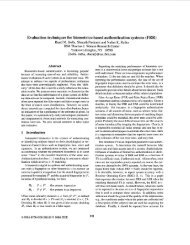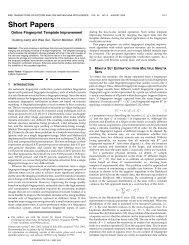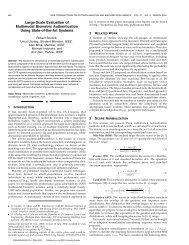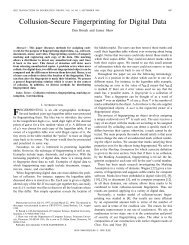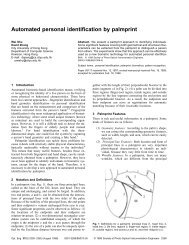Real-time embedded face recognition for smart home ... - IEEE Xplore
Real-time embedded face recognition for smart home ... - IEEE Xplore
Real-time embedded face recognition for smart home ... - IEEE Xplore
Create successful ePaper yourself
Turn your PDF publications into a flip-book with our unique Google optimized e-Paper software.
184<br />
<strong>IEEE</strong> Transactions on Consumer Electronics, Vol. 51, No. 1, FEBRUARY 2005<br />
Fig. 2. Face <strong>recognition</strong> operation flow.<br />
relatively unconstrained operating environment imposes more<br />
challenges compared to conventional ‘smug-shot’ <strong>face</strong><br />
<strong>recognition</strong> such as used in security applications. These extra<br />
challenges include the following:<br />
1. Large variability of operating environments (e.g.<br />
illumination and backgrounds).<br />
2. Processing efficiency with low-cost consumer<br />
hardware.<br />
3. Nearly unconstrained capturing of facial images.<br />
In this paper, we present a consumer-oriented <strong>face</strong><br />
<strong>recognition</strong> system HomeFace, with special emphasis on the<br />
above challenges. The system is <strong>embedded</strong> in a <strong>smart</strong> <strong>home</strong><br />
environment <strong>for</strong> user identification as illustrated in Fig. 1.<br />
More specifically, the experimental environment consists of a<br />
<strong>home</strong> network using e.g. Ethernet and <strong>IEEE</strong>-1394 connections.<br />
A prototype of our <strong>recognition</strong> system was integrated in this<br />
network and successfully demonstrated at the IFA consumer<br />
electronics exhibition [2].<br />
The remainder of the paper is organized as follows. In<br />
Section II, we will give an overview of the HomeFace system<br />
architecture. The core of the system is a pipeline of three<br />
processing modules, namely, <strong>face</strong> detection, facial feature<br />
extraction <strong>for</strong> <strong>face</strong> normalization, and finally, <strong>face</strong><br />
identification. Sections III-V illustrate each processing module<br />
in more detail. In Section VI, we provide the experimental<br />
results and analyze the per<strong>for</strong>mance of the complete system.<br />
Section VII presents discussions and conclusions.<br />
II. ARCHITECTURE OVERVIEW OF HOMEFACE<br />
The <strong>embedded</strong> HomeFace system consists of a kernel<br />
component per<strong>for</strong>ming the <strong>face</strong> detection/<strong>recognition</strong> and an<br />
interfacing component providing a uni<strong>for</strong>m inter<strong>face</strong> to<br />
different hosting devices. The kernel component employs a<br />
Fig. 3. Algorithm architecture.<br />
processing pipeline consisting of <strong>face</strong> detection (attention<br />
capture), feature extraction <strong>for</strong> <strong>face</strong> normalization<br />
(preprocessing <strong>for</strong> classification), and <strong>face</strong> identification.<br />
A. Processing flow<br />
Fig. 2 portrays the operation flow of the HomeFace system.<br />
The system operates on live-feed video from <strong>embedded</strong><br />
cameras and per<strong>for</strong>ms the identification in near real <strong>time</strong>. For<br />
each frame, the system detects existing <strong>face</strong>s and keeps track<br />
of the located <strong>face</strong>s (Fig. 2, stage A). Motions of <strong>face</strong>s from<br />
the same user <strong>for</strong>m a smooth trajectory, and a new user can be<br />
easily identified by detecting a ‘break’ of this trajectory. Note<br />
that in both cases, the subsequent facial feature extraction and<br />
<strong>face</strong> identification are per<strong>for</strong>med. From all detected <strong>face</strong>s,<br />
those <strong>face</strong>s with large rotations (in-plane or out-of-plane<br />
rotation) or low resolutions are discarded. The remaining <strong>face</strong><br />
images are selected as key samples <strong>for</strong> further processing (Fig.<br />
2, stage B). To accommodate <strong>for</strong> varying <strong>face</strong> scale, position<br />
and pose, an accurate extraction of salient facial features is<br />
required <strong>for</strong> normalization purposes (Fig. 2, stage C).<br />
The final <strong>face</strong> identification (Fig. 2, stage D) searches <strong>for</strong> a<br />
database of reference <strong>face</strong>s and returns the ‘best-match’. For a<br />
user coming into the scene <strong>for</strong> the first <strong>time</strong> (Fig. 2, stage E), a<br />
minimum of k key samples need to be processed be<strong>for</strong>e an<br />
identification decision is made. For users already present in the<br />
scene, the identification result <strong>for</strong> the current frame will only<br />
contribute to the accumulated <strong>recognition</strong> confidence (Fig. 2,<br />
stage F). In this way, more stable identification can be<br />
achieved w.r.t. a sequence of <strong>face</strong> images.<br />
The processing pipeline can be executed on one single<br />
processing unit (the centralized mode) or distributed over a<br />
number of processing units connected by a <strong>home</strong> network (the<br />
distributed mode). In the distributed mode, different<br />
processing tasks (e.g. <strong>face</strong> detection, facial feature extraction



